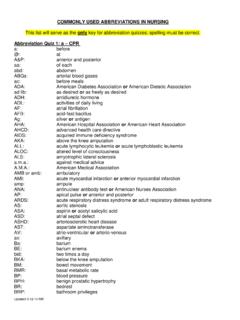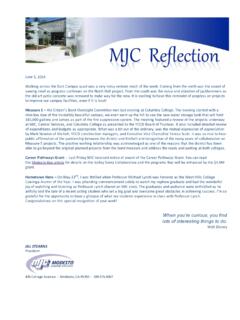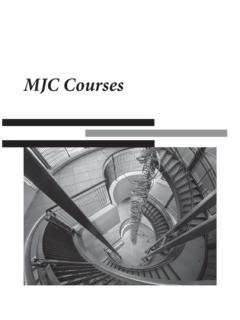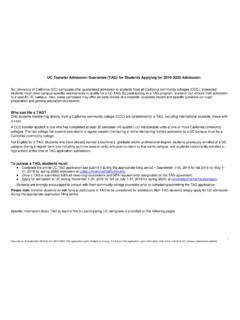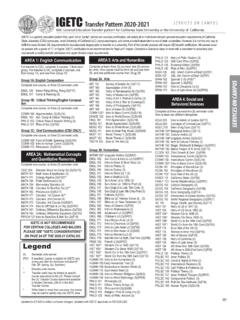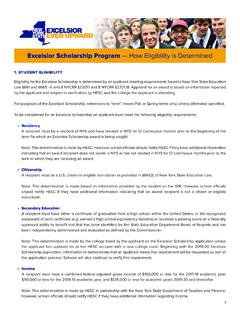Transcription of What is a Program Learning Outcome (PLO)?
1 24 | Page What is a Program Learning Outcome (PLO)? Program Learning outcomes are the skills, competencies, and big ideas students should be able to articulate, put into action, or utilize (theoretically or pragmatically) after the completion of a degree or certificate. As a general institutional practice, at MJC, the OAW has recommended that faculty construct 2-3 PLOs per degree or certificate. What is the definition of a Program ? The ASCCC s SLO Terminology Glossary notes that Program can be confusing: In Title 5 55000(g), a Program is defined as a cohesive set of courses that result in a certificate or degree .
2 However, in Program Review, colleges often define programs to include specific disciplines. A Program may refer to student service programs and administrative units, as well. programs , then, can come to mean different things. PLOs and programs . When we talk about PLOs at MJC, we mean the Learning outcomes that would be the expected measurable evidence of student Learning that occurs as a result of taking classes through Modesto Junior College. The PLOs for any given Program are expected to be attained when students are successful, and they are skills, competencies and big ideas faculty want students to comprehend and utilize during and after their Learning experience.
3 Program Review. When we talk about Program Review at MJC, we broadly mean Program as a department or area; in other words, departments or areas are responsible for a cohesive Program review and an analysis of their offerings and contributions. Program Review, written by academic departments, contains the analysis of all department PLOs and their respective degrees and certificates. PLOs, in other words, inform Program Review. Academic departments analyze their specific programs meaning degrees and certificates in their broad Program Review. Program Review by academic departments include an analysis of their PLOs (as well as GELOs and ILOs) alongside other data, rounding out their report into a cohesive document that encompasses all areas of student Learning and recommendations concerning how to improve.
4 25 | Page Where are PLOs stored, and are they publicly accessible for students and the community? PLOs for each Program can be found in four locations: First, PLOs are primarily housed in MJC s curriculum management database, CurricUNET. Any additions or changes to PLOs take place via CurricUNET. PLOs are also stored and assessed in eLumen. Second, PLO statements are publicly accessible for students and our community through the college website, on individual department pages and on the outcomes assessment page: Third, PLOs and their respective quantitative assessment data are publicly accessible for students and our community through the college research website and the outcomes assessment webpage above.
5 MJC has publicly accessible data dashboards for PLOs. Fourth, PLOs are publicly available accessible for students in the college catalog: after each degree or certificate description, corresponding PLOs are listed. In the college catalog, all PLOs are accessible for prospective and current students. Above is an example from Geography ( degree ). 26 | Page How are PLOs written? At MJC, PLOs for degrees and certificates begin with the following phrase: Upon satisfactory completion of this award, the student should be prepared to: What happens after this phrase is the responsibility of discipline faculty, and PLOs should be entered into CurricUNET (as well as double-checked in the catalog and assessment website).
6 Full-time faculty should construct and agree on the PLOs for the programs they offer and teach. Part-time faculty should be part of the conversation and informed of the current PLOs, as the CLOs they assess in classes should inform the PLOs for degrees and certificates. PLOs should draw on the same kinds of principles as CLOs (see the previous section, How are CLOs written? ), including the use of Bloom s Taxonomy and an emphasis on measurability (qualitative and quantitative). PLOs should be written in ways that strategically correspond to CLOs: the data from CLOs should quantitatively and qualitatively inform PLOs.
7 Part of the process of continual assessment improvement is working on the relationship between course and Program Learning outcomes. After completing assessment cycles, departments should examine the relationships between their CLOs and PLOs in order to provide adequate and meaningful data from both. 27 | Page What are some useful examples of PLOs being assessed? The OAW has recommended the following examples: Skills Recognition Award: Autobody/Refinishing Upon satisfactory completion of this award, the student should be prepared to: 1. Comply with current industry safety and environmental regulations.
8 2. Perform basic refinishing techniques in accordance with industry standards. Certificate of Achievement in Records Management/Data Entry Specialist Upon satisfactory completion of this award, the student should be prepared to: 1. Actively assist in implementing general office procedures, including records management. 2. Efficiently perform office-related duties utilizing prioritization and necessary communication skills. 3. Utilize computer software to manage data effectively. degree : University Preparation, Emphasis in Humanities Upon satisfactory completion of this award, the student should be prepared to: 1.
9 Analyze the ways that individuals and various cultural groups act in response to their societies and environment. 2. Demonstrate awareness of the various ways that culture, ethics, history, belief, and ethnicity affect individual experience and society as a whole. 3. Demonstrate the ability to interpret and analyze works of art for meaning and to forge aesthetic judgments. 4. Describe how cultural beliefs, values and practices have influenced societies in various times. 5. Demonstrate critical thinking in the analysis of cultural production using both thematic and historical synthesis. 28 | Page How can PLOs be modified or changed to make them better?
10 PLOs should be periodically examined throughout the assessment and curriculum update processes. If faculty agree on modifications, changes can occur in two ways. PLO Update. If the Program of record does not need any changes, faculty can perform a PLO update inside of CurricUnet. The process begins with launching a PLO Update, followed by a review by the Curriculum Committee, in its role as a committee of the Academic Senate, and then finalized for use by the SLO Coordinator. The PLOs are posted publicly online and in the next catalog, as well as ready for assessment by faculty in eLumen. PLO input or modification through Program Building or Updating.



